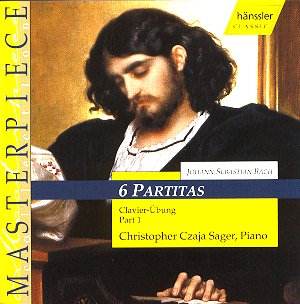Bach’s keyboard partitas were his first published works,
his opus 1. These six suites were actually the last suites Bach wrote
for keyboard, and owe a great deal to French influence. These are relatively
popular works, and have been recorded by most of the world’s leading
pianists. Christopher Czaja Sager gives an interesting reading of these
works, and, unlike most pianists, gives the partitas an additional level
of colour by playing them on three different pianos.
Sager plays the first partita at a relatively slow
tempo, similar to Wolfgang Rubsam’s interpretation on Naxos. This approach
is quite enjoyable to some, since it brings out totally different elements
of the music than when it is played at a faster tempo as most performers
do. Sager’s choice of a Yamaha piano gives this, and the third, fifth
and sixth partitas, an interesting sound. Less resonant than the more
common Steinway, this piano has an attractive tone that fits will with
some of the more lively movements.
Sager plays the sixth partita in a similar fashion
- the opening toccata is slow and sinuous, and he gives it a more improvisatory
sound than many other pianists. His overall performance of this partita
is excellent; his playing truly blossoms in this idiom.
The second partita benefits from a fine-sounding Bösendorfer
piano, with even less resonance than the Yamaha. This piano is more
compact both in size (2 metres, compared to 2.74 and 2.74 for the others),
and sound. Sager plays this partita much faster than the others, and
exudes less conviction. The allemande is very attractive, but the faster
movements, such as the final capriccio, sound a bit too inflexible.
The main problem with this set is that Sager takes
a very uneven approach to the partitas. While each individual work is
coherent, there is no overall vision. His differences in tempi - from
the relatively slow first partita to the fairly rapid fourth - show
that he does not see this as a set of works, but rather as a group of
individual, unrelated suites. Some of the partitas are excellent, others
just good. This is a set worth discovering, especially at its budget
price, but the listener should not expect to appreciate all of the works
in the same way.
Kirk McElhearn


